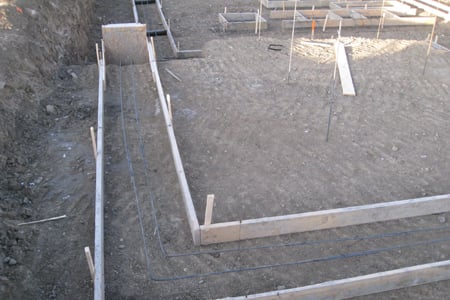
Site is excavated and footings are formed on top of the undisturbed soil. Reinforcing steel is used on the entire perimeter. All joints are overlapped.
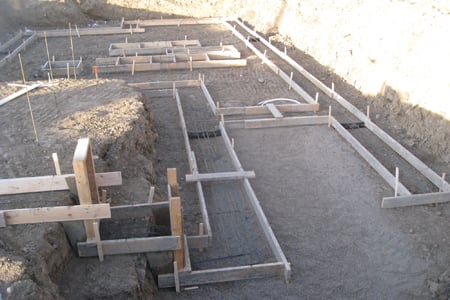
Weeping tile is used to allow water to travel continuously around the perimeter.
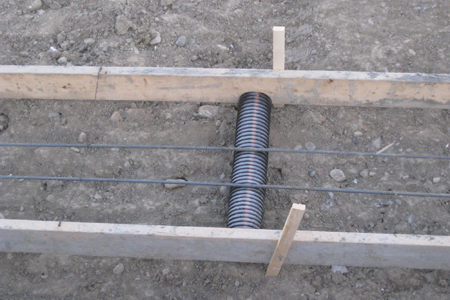
The piece of weeping tile will act as a tunnel for water to get through.
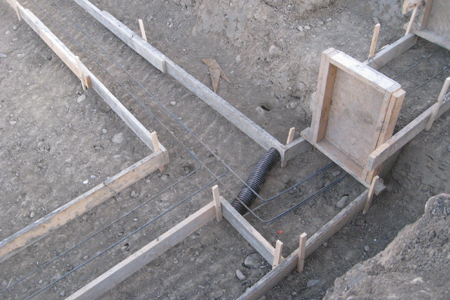
It is important that rebar be used on stepped footings.
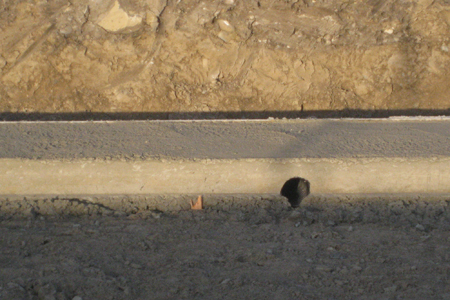
Concrete is poured and forms are stripped. Here we can see where weeping tile will be connected from exterior and will travel into the house portion.
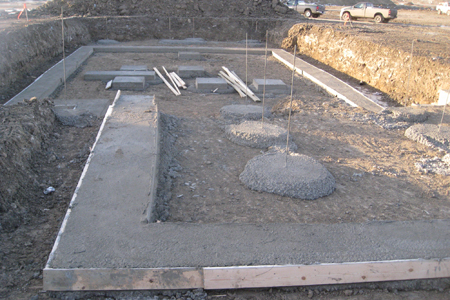
Concrete square pads are usually for teleposts. Round pads are used in this project to support garage concrete floor or deck columns.

If the ground is uneven it is important to pour concrete on top and not use any fill to level it.
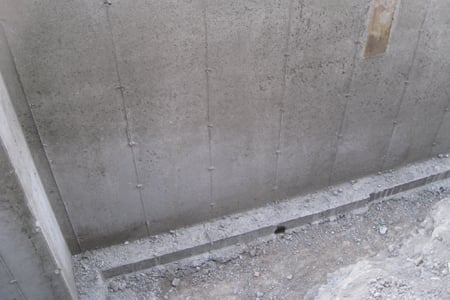
Foundation walls are formed, poured and stripped. Again we see the drain hole.
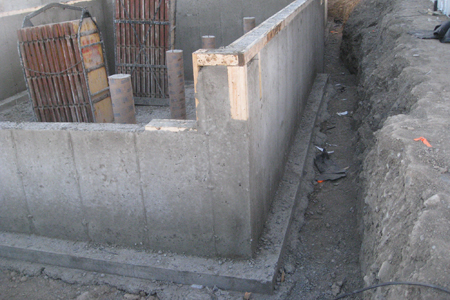
We can now see the concrete columns poured on top of the round pads we saw earlier. Typically garage walls are not as deep as the rest of the foundation.
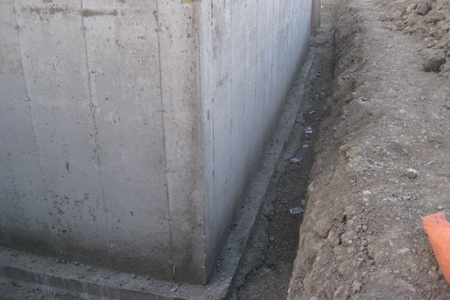
On top of the walls we can see wooden blocks that are inserted to allow for strapping which will be used for siding installation.
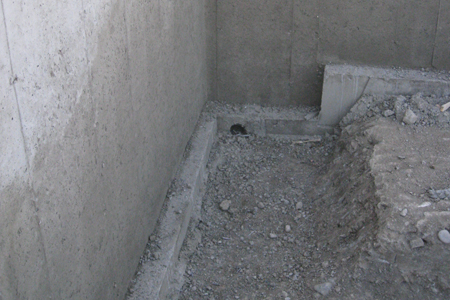
Stepped footing at garage and main house junction.
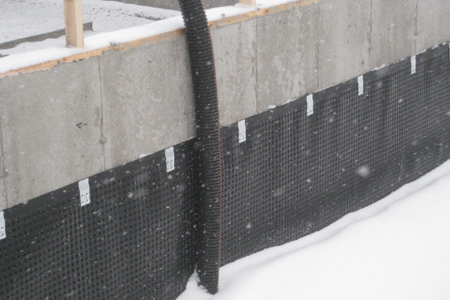
Weeping tile was installed and covered with washed rock. Vertical pieces are used to drain window wells.
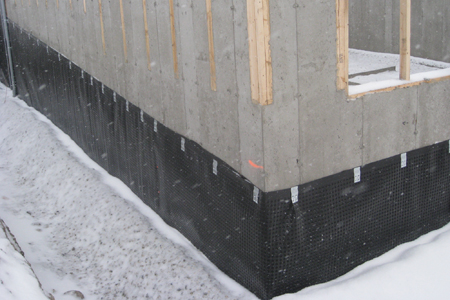
Foundation wrap was installed in this project. Wrap is not mandatory; foundation damp proofing can also be used.
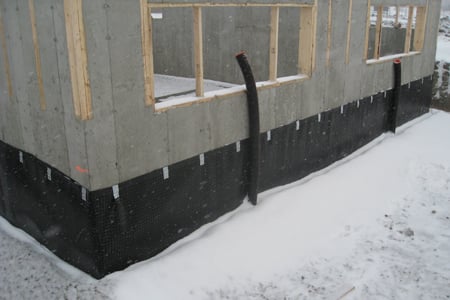
As per building code, this foundation is 1.2 meters below grade. The soil backfill will act as insulation to protect footings from frost.
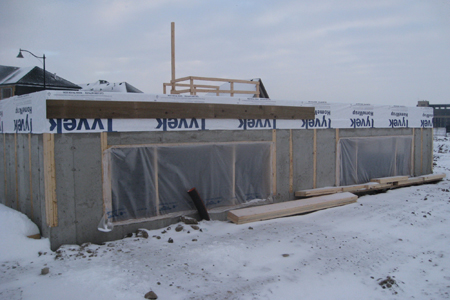
Foundation is backfilled.
 Site is excavated and footings are formed on top of the undisturbed soil. Reinforcing steel is used on the entire perimeter. All joints are overlapped.
Site is excavated and footings are formed on top of the undisturbed soil. Reinforcing steel is used on the entire perimeter. All joints are overlapped. Weeping tile is used to allow water to travel continuously around the perimeter.
Weeping tile is used to allow water to travel continuously around the perimeter. The piece of weeping tile will act as a tunnel for water to get through.
The piece of weeping tile will act as a tunnel for water to get through. It is important that rebar be used on stepped footings.
It is important that rebar be used on stepped footings. Concrete is poured and forms are stripped. Here we can see where weeping tile will be connected from exterior and will travel into the house portion.
Concrete is poured and forms are stripped. Here we can see where weeping tile will be connected from exterior and will travel into the house portion. Concrete square pads are usually for teleposts. Round pads are used in this project to support garage concrete floor or deck columns.
Concrete square pads are usually for teleposts. Round pads are used in this project to support garage concrete floor or deck columns. If the ground is uneven it is important to pour concrete on top and not use any fill to level it.
If the ground is uneven it is important to pour concrete on top and not use any fill to level it. Foundation walls are formed, poured and stripped. Again we see the drain hole.
Foundation walls are formed, poured and stripped. Again we see the drain hole. We can now see the concrete columns poured on top of the round pads we saw earlier. Typically garage walls are not as deep as the rest of the foundation.
We can now see the concrete columns poured on top of the round pads we saw earlier. Typically garage walls are not as deep as the rest of the foundation. On top of the walls we can see wooden blocks that are inserted to allow for strapping which will be used for siding installation.
On top of the walls we can see wooden blocks that are inserted to allow for strapping which will be used for siding installation. Stepped footing at garage and main house junction.
Stepped footing at garage and main house junction. Weeping tile was installed and covered with washed rock. Vertical pieces are used to drain window wells.
Weeping tile was installed and covered with washed rock. Vertical pieces are used to drain window wells. Foundation wrap was installed in this project. Wrap is not mandatory; foundation damp proofing can also be used.
Foundation wrap was installed in this project. Wrap is not mandatory; foundation damp proofing can also be used. As per building code, this foundation is 1.2 meters below grade. The soil backfill will act as insulation to protect footings from frost.
As per building code, this foundation is 1.2 meters below grade. The soil backfill will act as insulation to protect footings from frost. Foundation is backfilled.
Foundation is backfilled.